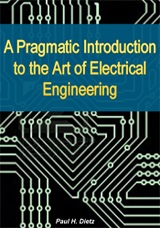
|
FreeComputerBooks.com
Links to Free Computer, Mathematics, Technical Books all over the World
|
|
- Title A Pragmatic Introduction to the Art of Electrical Engineering
- Author(s) Paul H. Dietz
- Publisher: Electrical Engineering Portal (EEP)
- License(s): "This book may be freely distributed to all, as long as the entire book is distributed in a substantially unmodified form"
- Paperback: N/A
- eBook: PDF (142 pages) and Video Lectures
- Language: English
- ISBN-10: N/A
- ISBN-13: N/A
- Share This:

|
This book provides a solid overview of the electrical engineering discipline that is especially geared toward the many non-electrical engineering students. The hallmark feature of the text is its liberal use of practical applications to illustrate important principles.
It delves into how and why electricity and electronics work, giving the reader the tools to take their electronics education to the next level. It is written in a down-to-earth style and explains jargon, technical terms and schematics as they arise.
It covers circuit analysis, digital systems, electronics, and electromechanics at a level appropriate for either electrical-engineering students in an introductory course or non-majors in a survey course.
About the Authors- N/A
- Electronic Engineering
- Microcontrollers, PLC, VLSI, etc.
- Embedded Systems
- Electrical and Computer Engineering

- A Pragmatic Introduction to the Art of Electrical Engineering (Paul H. Dietz)
- The Mirror Site (1) - PDF
- The Mirror Site (2) - PDF
- Introduction to Electrical Engineering (Mulukutla S. Sarma)
-
 Art + DIY Electronics (Garnet Hertz)
Art + DIY Electronics (Garnet Hertz)
This book documents, tracks, and identifies a hundred years of innovative DIY technology practices, illustrating how the maker movement is a continuation of a long-standing creative electronic subculture.
-
 Semiconductor Devices: Theory and Application (James M. Fiore)
Semiconductor Devices: Theory and Application (James M. Fiore)
Covers the theory and application of discrete semiconductor devices including various types of diodes, bipolar junction transistors, JFETs, MOSFETs and IGBTs. Applications include rectifying, clipping, clamping, switching, small signal amplifiers and followers.
-
 Principles of Semiconductor Devices (Bart Van Zeghbroeck)
Principles of Semiconductor Devices (Bart Van Zeghbroeck)
The purpose of this textbook is to explore the internal behavior of semiconductor devices, so that we can understand the relation between the device geometry and material parameters on one hand and the resulting electrical characteristics on the other hand.
-
 Understanding Electronics Components (Filipovic D. Miomir)
Understanding Electronics Components (Filipovic D. Miomir)
This book is meant for those people who want to create electronic devices with their own hands. All components are illustrated and the circuit-symbol is explained in detail. Both simple and complex examples are provided for the beginners.
-
 Probability in Electrical Engineering and Computer Science (EECS)
Probability in Electrical Engineering and Computer Science (EECS)
This textbook motivates and illustrates the techniques of applied probability by applications in electrical engineering and computer science (EECS). Python labs enable the readers to experiment and consolidate their understanding.
-
 Electrical Circuit Analysis (Jim Pytel)
Electrical Circuit Analysis (Jim Pytel)
This book has been written for students on electrical engineering courses who don't necessarily possess prior knowledge of electrical circuits, based on the author's own teaching experience.
-
 Lessons in Electric Circuits (Tony R. Kuphaldt)
Lessons in Electric Circuits (Tony R. Kuphaldt)
A 6 volumes series of textbooks on the subjects of electricity and electronics. This book was written to be a good enough book without delving too heavy on the math, while still maintaining a lot of important information.
-
 DC Electrical Circuit Analysis: A Practical Approach (James Fiore)
DC Electrical Circuit Analysis: A Practical Approach (James Fiore)
Basic concepts are introduced such as charge, current, energy, power and voltage. Covering analysis techniques such as superposition, source conversions, mesh analysis, nodal analysis, , Thévenin's and Norton's theorems, and delta-wye conversions, etc.
-
 AC Electrical Circuit Analysis: A Practical Approach (James Fiore)
AC Electrical Circuit Analysis: A Practical Approach (James Fiore)
Cover topics including series, parallel, and series-parallel RLC circuits. Numerous theorems and analysis techniques are examined including superposition, Thévenin's theorem, nodal and mesh analysis, maximum power transfer and more.
-
 Operational Amplifiers and Linear Integrated Circuits
Operational Amplifiers and Linear Integrated Circuits
This book offers an extensive and detailed exploration of the modern op amp and associated specialized linear integrated circuits. The exploration begins with a fundamental building building block, the differential amplifier.
-
 An Introduction to Electronics (WikiBooks)
An Introduction to Electronics (WikiBooks)
The aim of this book is to explain the design and function of electronic circuits and components. It covers electronic circuit components, DC analysis, and AC analysis, and provides readers with a broad overview of both the linear and digital fields of electronics.
-
 Designing Analog Chips (Hans Camenzind)
Designing Analog Chips (Hans Camenzind)
A comprehensive introduction to CMOS and bipolar analog IC design. The book presumes no prior knowledge of linear design, making it comprehensible to engineers with a non-analog background.





